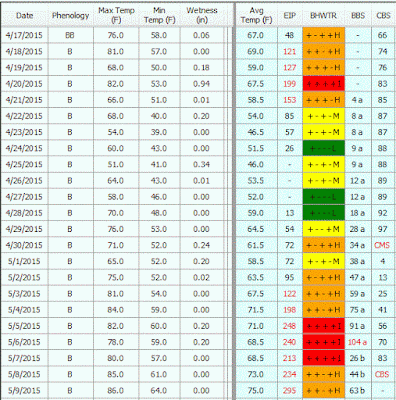CAUTION: The
observations, conditions, and recommendations reported for Winchester, VA are
provided as a guide to fire blight risk assessment only for the immediate area
of the Virginia Tech AREC located six miles southwest of Winchester. Use of the
information reported here for making orchard management decisions outside of
that area is not my intent. Fruit producers outside of that area are
encouraged to consult their state extension specialists for information similar
to that provided here.
 |
| (Click image for larger view) |
Based on predicted temperatures, EIP will remain at an infective level through this entire week, requiring only wetting to trigger infection conditions wherever susceptible bloom is present. Wetting from rain is shown as being predicted for May 5 and 6; other forms of wetting capable of triggering infection conditions include heavy dew, fog or routine spray applications-- any wetting event that will move the fire blight bacteria from the flower stigma into the nectaries in the base of the flower. It is recommended that streptomycin be included with any routine spray applications in high risk situations this week. Under the temperature conditions shown for this week, expect streptomycin to remain residually effective for only about 3 days.
The BBS
column is tracking predicted appearance of blossom blight symptoms from
infection that occurred Apr 20, and this is predicted for May 6. (Actually we
are already seeing early symptoms from test inoculations Apr 20). The CBS
column at the right in the graphic predicts the appearance
of canker margin symptoms due to extension of overwintering cankers by Apr 30. Canker advancement cannot be prevented
by treatment at this time and the presence of symptoms will signal
build-up of inoculum which could become a factor in the event of a trauma
blight situation due to hail injury, etc.
The weather
conditions used in the predictive part of this graphic come from the WeatherChannel for Winchester, supplemented by site-specific data from SkyBit Inc. Be
aware that risk can change quickly with unpredicted warmer temperatures and
wetting.
FUNGAL DISEASES
We recorded our 7th apple scab infection period of the year May 1-2 (15 hr at 58-53° with 0.21 in. of rain). This also favored quince rust fruit infection and cedar-apple rust on foliage and flowers. Apple scab lesions were first observed at our AREC last week; now some leaves on unprotected trees have as many as six lesions per leaf. Also present are cedar-apple rust lesions, probably from infection that occurred April 14. Powdery mildew is our only "dry weather" fungal disease on apples. So far, we have had 13 “mildew infection days” since spores first became available Apr 6.
